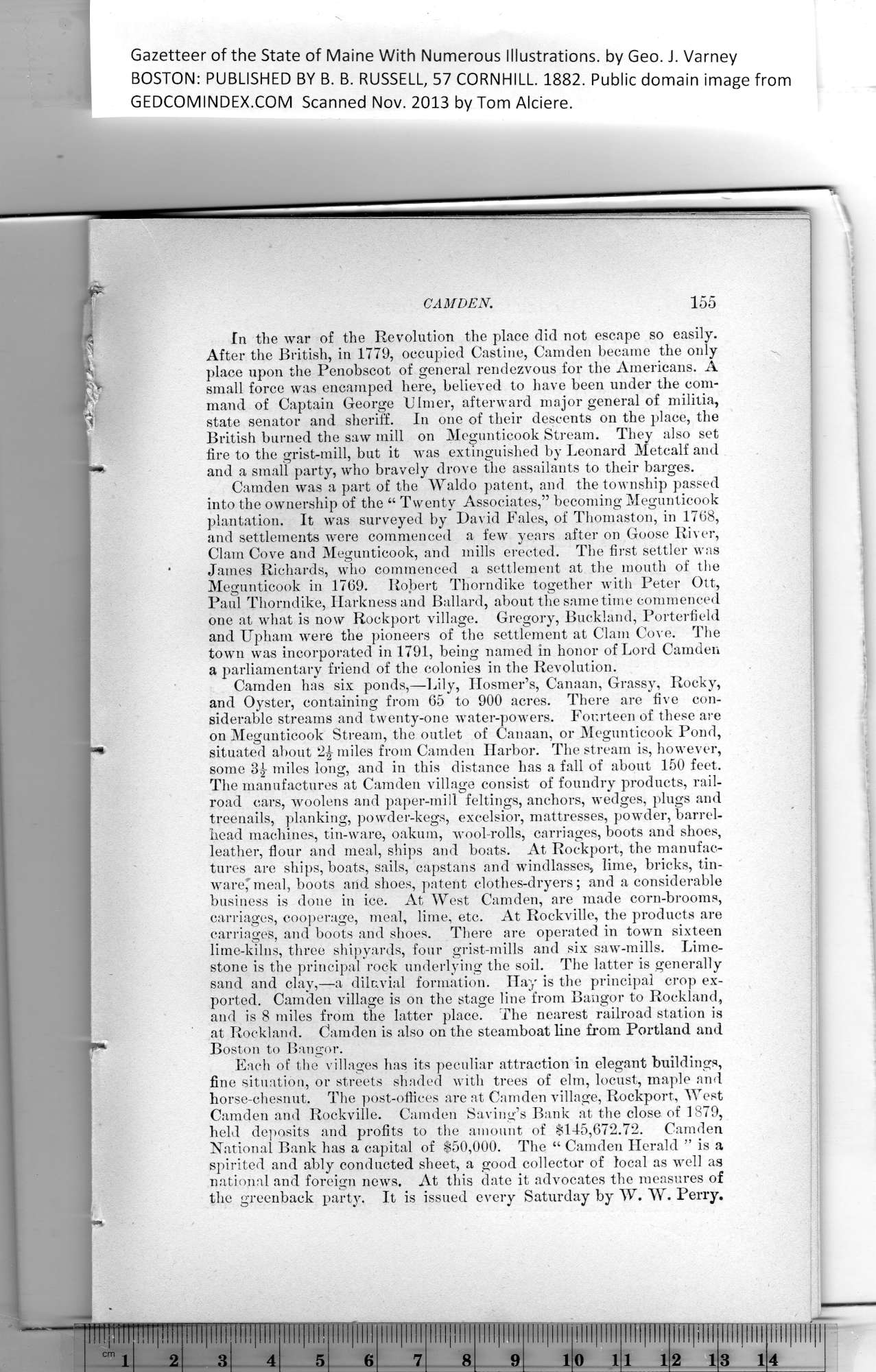|
Gazetteer of the State of Maine With Numerous Illustrations, by Geo. J. Varney
BOSTON: PUBLISHED BY B. B. RUSSELL, 57 CORNHILL. 1882. Public domain image from
CAMDEN. 155
In the war of the Revolution the place did not escape so easily.
After the British, in 1779, occupied Castine, Camden became the only
place upon the Penobscot of general rendezvous for the Americans. A
small force was encamped here, believed to have been under the com-
mand of Captain George Ulmer, afterward major general of militia,
state senator and sheriff. In one of their descents on the place, the
British burned the saw mill on Megunticook Stream. They also set
fire to the grist-mill, but it was extinguished by Leonard Metcalf and
and a small party, who bravely drove tbe assailants to their barges.
Camden was a part of tbe Waldo patent, and the township passed
into the ownership of the “ Twenty Associates,” becoming Megunticook
plantation. It was surveyed by David Fales, of Thomaston, in 1768,
and settlements were commenced a few years after on Goose River,
Clam Cove and Megunticook, and mills erected. The first settler was
James Richards, who commenced a settlement at the mouth of the
Megunticook in 1769. Robert Thorndike together with Peter Ott,
Paul Thorndike, Harkness and Ballard, about the same time commenced
one at what is now Rockport village. Gregory, Buckiand, Porterfield
and Upham were the pioneers of the settlement at Clam Cove. The
town was incorporated in 1791, being named in honor of Lord Camden
a parliamentary friend of the colonies in the Revolution.
Camden has six ponds,—Lily, Hosmer’s, Canaan, Grassy, Rocky,
and Oyster, containing from 65 to 900 acres. There are five con-
siderable streams and twenty-one water-powers. Fourteen of these are
on Megunticook Stream, the outlet of Canaan, or Megunticook Pond,
Situated about 2£ miles from Camden Harbor. The stream is, however,
some 3-§- miles long, aud in this distance has a fall of about 150 feet.
The manufactures at Camden village consist of foundry products, rail-
road cars, woolens and paper-mill feltings, anchors, wedges, plugs and
treenails, planking, powder-kegs, excelsior, mattresses, powder, barrel-
head machines, tin-ware, oakum, wool-rolls, carriages, boots and shoes,
leather, flour and meal, ships and boats. At Rockport, the manufac-
tures are ships, boats, sails, capstans and windlasses, lime, bricks, tin-
ware^meal, boots and shoes, patent clothes-dryers; and a considerable
business is done in ice. At West Camden, are made corn-brooms,
carriages, cooperage, meal, lime, etc. At Rockville, the products are
carriages, and boots and shoes. There are operated in town sixteen
lime-kilns, three shipyards, four grist-mills and six saw-mills. Lime-
stone is the principal rock underlying the soil. The latter is generally
sand and clay,—a diluvial formation. Hay is the principal crop ex-
ported. Camden village is on the stage line from Bangor to Rockland,
and is 8 miles from the latter place. The nearest railroad station is
at Rockland. Camden is also on the steamboat line from Portland and
Boston to Bangor.
Each of the villages has its peculiar attraction in elegant buildings,
fine situation, or streets shaded with trees of elm, locust, maple and
horse-chesnut. The post-offices are at Camden village, Rockport, West
Camden and Rockville. Camden Saving’s Bank at the close of 1879,
held deposits and profits to the amount of $145,672.72. Camden
National Bank has a capital of $50,000. The “ Camden Herald ” is a
spirited and ably conducted sheet, a good collector of local as well as
national and foreign news. At this date it advocates the measures of
the greenback party. It is issued every Saturday by W. W. Perry.
PREVIOUS PAGE ... NEXT PAGE
This page was written in HTML using a program written in Python 3.2
|
